Answer these simple questions and we will find you the BEST prices
Which type of solar quotes do you need?
It only takes 30 seconds
100% free with no obligation

Tell us what you need to find a matching specialist

Get free quotes from professionals near you

Compare offers and choose the one that best matches your need
- whatcost.co.uk
- Home Insulation
- Wall Insulation
- Cavity Wall Insulation
- Party Wall Cavity Insulation
Party Wall Cavity Insulation: Complete 2025 Guide

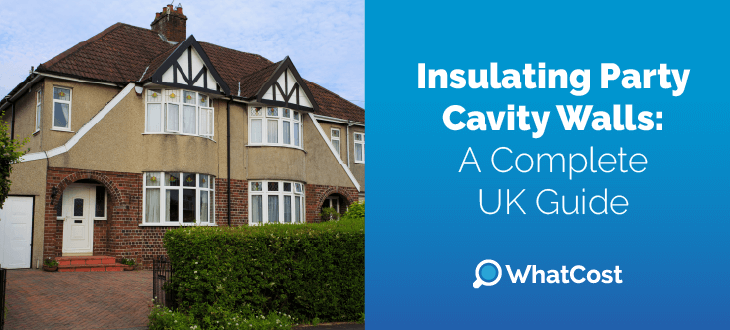
- Party wall cavity insulation can save up to £340 per year on energy bills.
- Insulating a party wall can cost between £13 and £30 per m2, depending on the insulation material chosen and the installation complexity.
- The three main types of party wall cavity insulation are EPS polystyrene beads, blown mineral wool, and spray foam insulation.
Party walls - shared walls between neighbouring properties - play a crucial role in cavity wall insulation soundproofing and energy efficiency. However, many homes in the UK lack adequate insulation in these shared walls, leading to increased energy consumption and noise disturbances.
This complete guide by WhatCost explores the benefits of party cavity wall insulation, including potential energy savings of up to £340 per year, reduced noise transmission, and increased home comfort. We'll delve into the different types of insulation materials available, and guide you through the considerations for installing party wall insulation for your home.
Ready to insulate your party walls? Look no further than WhatCost for a one-stop solution for all your needs. All you need is 30 seconds to fill out our online form, and we’ll send you 3 free home-tailored quotes from our network of trusted installers. No costs, no obligations. Simply click below to begin and let the bargains come to you!
- What is the role of party wall insulation in homes?
- What is the installation process for party wall cavity wall insulation?
- Types of party wall insulation
- How much does party wall insulation cost?
- What are the building regulations for party wall insulation?
- Pros & cons of insulating a party wall
- Is party wall insulation worth it?
- FAQ
What is the role of party wall insulation in homes?
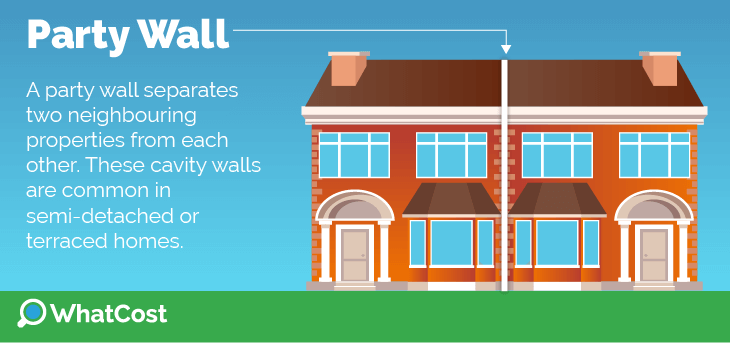
What is party wall insulation? Party walls are shared walls that separate neighbouring properties from each other. These are most common in semi-detached or terraced houses typically built before the 1990s. In older homes, these walls often lack adequate insulation, leading to several issues such as:
- Noise transmission: Insufficient soundproofing allows noise to easily travel between properties, disrupting the peace and privacy of residents. While cavity wall sound insulation requires special acoustic materials designed for party wall cavity sound insulation, even basic thermal insulation can help dampen some noise.
- Heat loss: Heat can easily escape through poorly insulated party walls, increasing energy consumption and heating bills.
Party wall insulation can be done during construction, or retrofitted into existing homes with cavity wall insulation. By investing in insulation party wall, homeowners can enhance the energy efficiency of their properties and save significantly on their energy bills.
What is the installation process for party wall cavity wall insulation?
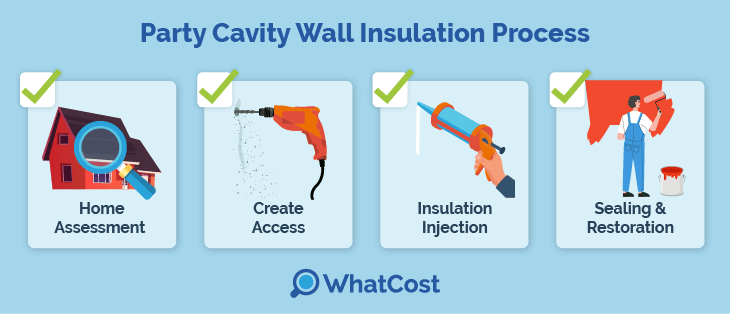
Cavity wall insulation installation requires a careful and methodical approach to ensure effective thermal separation between neighbouring properties. While still cavity wall insulation, it can be more tedious than a standard job.
Here's a breakdown of the typical process:
-
Home assessment: The process begins with thoroughly assessing the party wall. This includes determining its suitability for insulation and selecting the most appropriate insulation material based on its characteristics (e.g., thickness, existing conditions).
Creating access: Small access holes are carefully drilled into the wall at intervals. This allows insulation material to be injected into the cavity while minimising disruption to the wall structure. - Insulation injection: Using specialised equipment, the chosen insulation material, such as mineral wool, foam, or polystyrene beads, is injected or blown into the cavity space through the drilled holes. This creates a continuous barrier against heat transfer.
- Sealing and restoration: Once the insulation is in place, the access holes are carefully sealed. The wall surface is then restored to its original condition, ensuring minimal disruption to the property's aesthetics.
While a relatively non-invasive process, this job cannot be carried out as a DIY project due to the involvement of complex processes and industry equipment. A professional installer is not just recommended, it is required.
Types of party wall insulation
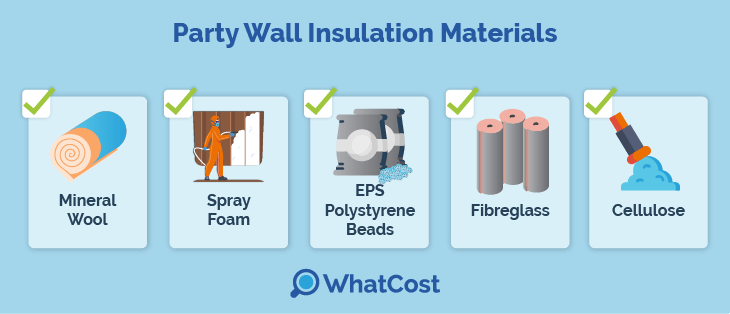
Party wall insulation enhances energy efficiency and improves the overall comfort within a property through temperature regulation. For non-insulated party walls, thermal insulation may even provide slight improvements to soundproofing.
While there is no single best cavity wall insulation, several key materials are commonly used in this process:
- Mineral wool: Derived from natural or synthetic minerals, mineral wool excels in both thermal and acoustic insulation. Its fire resistance and durability make it a reliable and robust choice for party walls.
- Spray foam: Typically polyurethane-based, the foam expands to fill gaps, creating an effective seal against heat loss and significantly improving energy efficiency. This can make it a cost-effective option.
- EPS polystyrene beads: These lightweight beads fill cavities and provide excellent thermal insulation. They can be secured with adhesive to prevent movement and maintain insulation integrity.
- Fibreglass: Composed of fine glass fibres, fibreglass offers strong thermal and acoustic properties. Its non-combustible nature, moisture resistance, and relatively easy installation make it a popular and safe choice for party wall insulation.
- Cellulose: Made from recycled paper treated for fire resistance, cellulose insulation is an environmentally friendly and highly efficient thermal insulator. Proper installation techniques are crucial to ensure optimal performance.
Does cavity wall insulation need renewing? Absolutely, however a proper insulation can exceed 25+ years of comfortable insulation, with some reports claiming up to a century of function.
Selecting the best party wall insulation depends on factors such as your budget, desired level of thermal efficiency, and personal preferences. Consulting with a qualified insulation professional is recommended to determine the most suitable option for your individual needs.
How much does party wall insulation cost?
The cost of cavity wall insulation for a party wall varies depending on several factors, including home size, type, chosen materials, insulation complexity, outstanding repairs, etc. To give you a better idea, here’s a cost breakdown of each insulation material and its average cost per m2:
| Insulation material | Cost per m2 |
|---|---|
| Mineral wool | £15 - £25 |
| Spray foam | £25 - £50 |
| EPS polystyrene beads | £10 - £20 |
| Fibreglass | £5 - £10 |
| Cellulose | £10 - £12 |
To help low-income and fuel-poor houses, the UK government has implemented two schemes to support homeowners in improving their home's energy efficiency:
- The Great British Insulation Scheme (GBIS): This scheme offers grants for eligible homes for single insulation measures, including party wall insulation. You can apply directly through the official UK government portal.
- The ECO4 Scheme requires energy companies to assist eligible households with home efficiency upgrades, including party wall insulation. Contact your energy provider to learn more about eligibility and apply.
Instead of spending endless hours surfing websites and scheduling phone calls to find a perfect installer within your budget, spend just 30 seconds filling out our online application form to receive up to 3 free home-tailored quotes from our nationwide network. No costs, no obligations. Simply click below to begin!
What are the building regulations for party wall insulation?
When insulating, it's crucial to adhere to current party wall insulation building regulations. These regulations aim to ensure energy efficiency and safety. Professional insulation experts are well aware of these regulations and can ensure that they are adhered to.
Some basic conditions are expected for party wall insulation, most importantly being:
- Property age: Homes built between the 1920s and 1980s generally have cavity walls instead of solid walls. Since the 1980s, building regulations have mandated the inclusion of insulation within cavity walls of newly constructed homes.
- Wall thickness: Outer walls of cavity walls must have a minimum thickness of 260mm.
To ensure full compliance with the UK Building Regulations, one can refer to the relevant guidance documents for your region:
- England: Approved Document L 2021 (ADL 2021)
- Wales: Approved Document L 2022 (ADL 2022)
- Scotland: Technical Handbook 6 2022 (TH6 2022)
These documents provide detailed guidance on meeting the energy efficiency standards outlined in the UK Building Regulations. To save yourself the tedious work, aim to hire a PAS 2030-2035 accredited installer who is qualified to carry out a cavity wall insulation check, as well as a professional job within regulation.
Pros & cons of insulating a party wall
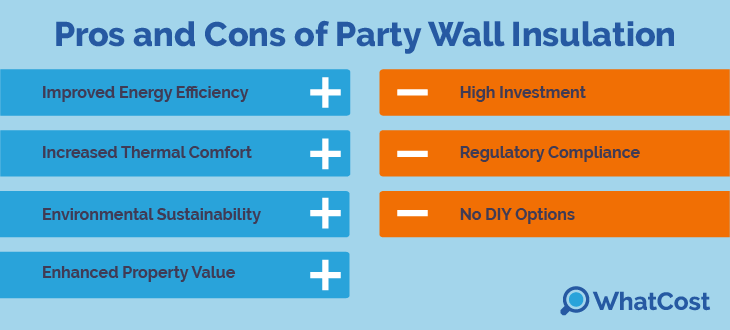
Party wall insulation often emerges as a valuable option that brings with it a wealth of benefits, especially to older homes with outdated insulation. However, as with any home improvement project, it's crucial to weigh the potential benefits and drawbacks.
To begin with, let’s have a look at some of the key advantages of party wall cavity wall insulation:
- Improved energy efficiency: By filling the air gap within the party wall with insulating material, heat loss through the wall can be reduced by up to 33%. This leads to lower heating bills and substantial savings on energy consumption.
- Increased thermal comfort: Consistent indoor temperatures are a key aspect of comfortable living. Party wall insulation helps to maintain a more stable indoor temperature, minimising fluctuations caused by external temperature changes.
- Environmental sustainability: Reduced energy consumption translates to a lower carbon footprint. By minimising reliance on heating systems, party wall insulation contributes to a more sustainable and environmentally friendly lifestyle.
- Enhanced property value: Energy-efficient homes are highly sought after in today's market. Party wall insulation can significantly enhance a property's value, making it more attractive to potential buyers.
Now that we have a solid understanding of the key benefits, it’s also important to understand the potential drawbacks. Here’s a rundown of some of the key drawbacks:
- High investment: Party wall insulation can involve a significant upfront cost, varying depending on the type of insulation used, the size of the wall, and the complexity of the installation.
- Regulatory compliance: Party wall insulation jobs often adhere to strict building regulations and may necessitate obtaining consent from neighbouring property owners. This process can involve legal and administrative complexities.
- No DIY options: Due to the nature of party walls and the potential complexities involved, professional installation is not just recommended, it's required.
Is party wall insulation worth it?
While the initial investment and potential regulatory hurdles of party wall cavity wall insulation may seem daunting at first, the long-term benefits are substantial. Improved comfort, enhanced energy efficiency, thermal balance, and reduced environmental impact all contribute to a more enjoyable and sustainable living experience.
For party wall acoustic insulation, it's important to utilise acoustic materials that are specifically designed for party wall noise insulation. This also includes adhering to party wall sound insulation building regulations and working with sound insulation party wall experts.
However, deciding to insulate your party walls is just the beginning of the journey. Next up, you’ll need to hire a professional accredited installer to carry out the job. That way, you can be sure to get a professional job that follows party wall insulation requirements. Sadly, finding the perfect balance between cost and professionalism can have you endlessly scouring websites with no bargain in sight. Luckily, WhatCost can help you out.
All it takes is 30 seconds to fill out our online application, and we’ll send you up to 3 free home-tailored quotes from our network of pre-vetted professionals. The best part? Our services are completely free of charges or obligations. Just click below to begin and let the bargains come to you!
FAQ
A party wall should be insulated to maximise thermal comfort within your property, as well as potentially reduce sound transfer between neighbours. This process alone can reduce your heat loss significantly, leading to energy bill savings and a smaller CO2 footprint.
The cheapest way to improve sound insulation in a cavity wall is to use thermal insulation materials like mineral wool or fibreglass. While these offer minor sound-dampening benefits, they aren’t effective if significant noise reduction is required.
Soundproofing a party wall can be effective, but requires careful consideration. Thermal insulation offers minimal sound reduction. For best results, install high-quality acoustic insulation (like mass-loaded vinyl or acoustic cotton) as internal wall insulation.
Damp-proofing a party wall requires addressing pre-existing issues like cracks and gaps. Moisture-resistant insulation, such as EPS polystyrene beads is a great option, especially for older homes. Proper ventilation is also essential for effective damp-proofing.

Akif has a keen interest in green home improvement solutions and the role of digital media in identifying climate trends. He aims to provide a multidisciplinary approach to content rooted in credible research and accuracy.
- Party Wall Cavity Insulation: Complete 2025 Guide
- What is the role of party wall insulation in homes?
- What is the installation process for party wall cavity wall insulation?
- Types of party wall insulation
- How much does party wall insulation cost?
- What are the building regulations for party wall insulation?
- Pros & cons of insulating a party wall
- Is party wall insulation worth it?
- FAQ
